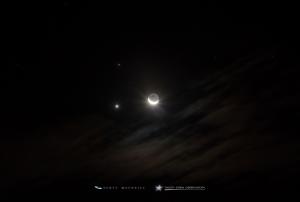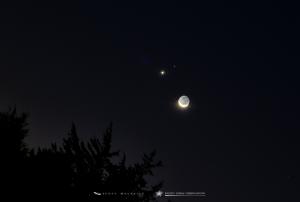
Stargazing Nights
- Where:
- Frosty Drew Observatory
- When:
- Friday January 27, 2017 at 6:00 p.m.
- Cost:
- $1 Suggested Donation per Person
Tonight is Stargazing Night at Frosty Drew Observatory and forecasts are looking rather variable. We can expect partly cloudy skies in the evening, becoming clear overnight. There is a slight chance of rain/snow showers, though less likely. We can also expect some wind with gusts possibly reaching into the 30 mph range, but nothing we can’t deal with. We are hopeful that tonight’s weather will favor us since tonight brings the New Moon and fabulously dark skies for the entire night.
We will open the Observatory and Sky Theatre at 6:00 tonight. In the Observatory, telescopes will start off with twilight views of Venus, which has moved into its crescent phase, followed by views of Uranus. Once twilight wanes, we will direct our telescopes toward dozens of nebulae, star clusters, and galaxies; including the fabulous Orion Nebula and the Messier 46 open star cluster. In the Sky Theatre temps will be warm and on screen will be our popular showcase of celestial objects photographed at Frosty Drew Observatory. We will stay open until 11:30 p.m. if clouds cut us a break, with much later times possible. Following @FrostyDrewOBSY on twitter (https://twitter.com/FrostyDrewOBSY) will get you updates from observatory on sky conditions and a “Closing up” post when we decide to pack up for the night. Our Twitter posts are also available on our Facebook (https://www.facebook.com/FrostyDrewObservatory) and on the desktop version of our website (https://frostydrew.org/observatory/), along the bottom right pane.
Overall, tonight is a bit of a wild card. Forecasts are calling for periodic bouts of clouds, with a lot of variability in how heavy cloud cover will be and what times we will see clearings. One forecast model is calling for a chance of rain/snow. Hey, this is New England. What puts tonight on the awesome map is the New Moon. These are, no doubt, the best nights to be out under the stars at Frosty Drew. The lack of any ambient moonlight allows for thousands of stars to blaze our night sky. On these nights the Milky Way becomes quite visible and our telescopes rock hundreds of objects not visible under moonlit skies. So take the night as it goes. We always make a best-effort attempt to view the night sky and we want to see that fabulous starscape tonight.
Tonight is Stargazing Night at Frosty Drew Observatory and forecasts are looking rather variable. We can expect partly cloudy skies in the evening, becoming clear overnight. There is a slight chance of rain/snow showers, though less likely. We can also expect some wind with gusts possibly reaching into the 30 mph range, but nothing we can’t deal with. We are hopeful that tonight’s weather will favor us since tonight brings the New Moon and fabulously dark skies for the entire night.
We will open the Observatory and Sky Theatre at 6:00 tonight. In the Observatory, telescopes will start off with twilight views of Venus, which has moved into its crescent phase, followed by views of Uranus. Once twilight wanes, we will direct our telescopes toward dozens of nebulae, star clusters, and galaxies; including the fabulous Orion Nebula and the Messier 46 open star cluster. In the Sky Theatre temps will be warm and on screen will be our popular showcase of celestial objects photographed at Frosty Drew Observatory. We will stay open until 11:30 p.m. if clouds cut us a break, with much later times possible. Following @FrostyDrewOBSY on Twitter will get you updates from observatory on sky conditions and a “Closing up” post when we decide to pack up for the night. Our Twitter posts are also available on our Facebook and on the desktop version of our website, along the bottom right pane.
Overall, tonight is a bit of a wild card. Forecasts are calling for periodic bouts of clouds, with a lot of variability in how heavy cloud cover will be and what times we will see clearings. One forecast model is calling for a chance of rain/snow. Hey, this is New England. What puts tonight on the awesome map is the New Moon. These are, no doubt, the best nights to be out under the stars at Frosty Drew. The lack of any ambient moonlight allows for thousands of stars to blaze our night sky. On these nights the Milky Way becomes quite visible and our telescopes rock hundreds of objects not visible under moonlit skies. So take the night as it goes. We always make a best-effort attempt to view the night sky and we want to see that fabulous starscape tonight.
------------------
Weekly Happenings
Scott MacNeill
Tonight brings the New Moon, and with it comes the return of the super thin waxing crescent Moon to our evening sky starting tomorrow and lasting for about a week before first quarter happens. Thin crescent phases offer up fabulous viewing opportunities of the Moon all without the loss of super dark skies.
A stunning sight, certainly not to miss, that is exclusive to crescent phases of the Moon, is called earthshine. This happens when sunlight reflecting off of the Earth’s daytime area illuminates the nighttime side of the Moon, giving it a ghostly glow alongside the brightly lit crescent. Earthshine is at its brightest when the Moon is positioned in a thin crescent phase and high enough above the horizon at sunset keeping the Moon visible during the latter half of twilight, when darkness really starts to set in.
Crescent phases also bring excellent conjunction viewing opportunities. As the crescent Moon progresses nightly along the ecliptic region (the path the Sun takes across the sky and the plane of the Solar System), it will visibly encounter some of the brighter planets that are found along the ecliptic, including Venus, Mars, Jupiter and Saturn. Conjunctions are not actually close encounters of the Moon and planets, but only appear to be close due to our viewing angle. One such conjunction will happen on Tuesday, January 31, 2017, when the 17% waxing crescent Moon meets up with Venus and Mars. The conjunction will remain visible for a couple of hours, starting around 5:30 p.m. and continuing until Venus drops below the horizon.
Dark skies still rock during crescent phases of the Moon, especially the thinnest. This is because the daytime side of the Moon, in direct sunlight, is only slightly visible to the Earth. This will substantially reduce the amount of moonlight cast into Earth’s atmosphere. Additionally, and more importantly, the Moon will set early in the night allowing longer periods of darkness with no Moon in the sky. Once the first quarter Moon arrives and the lunar phase switches to waxing gibbous, the Moon is above the horizon for longer periods of the night than it is not, reducing the amount of time we can celebrate dark skies.
Take a moment over the next week to step out during twilight and catch a memorable view of the fabulous crescent Moon, Earthshine, and a conjunction on the 31st. Perhaps make it a stargazing night and escape from the daily stresses of your week. This is time to be out hunting for dark sky locations and reveling in the vast starscape, before the return of the brighter lunar phases.
-Scott



